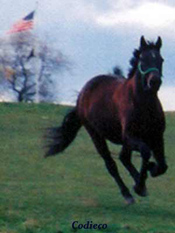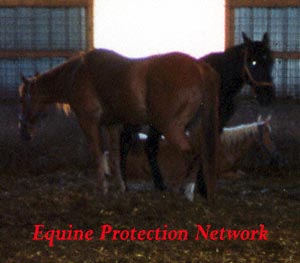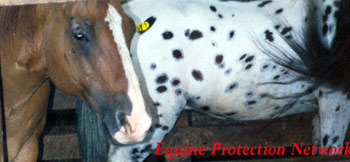
Horse Slaughter
- USDA, FSIS Promotes Eating American Horses!
- Euthanasia Procedures
- PA Rendering Companies
- PA Dead Animal Act -PA Law regarding Removal of Dead Animals-Is it Against PA Law to Bury Your Horse?
Links
California Voters "Just Say Neigh" to Horse Slaughter!
HoofPAC
Shop online at IGive.com with over 400 great stores you know & love- including Back In the Saddle! Up to 26% of the purchase price is donated to the EPN!
The EPN gets $5 extra the first time you shop!
PayPal accepts credit cards! Please send your tax deductible donation to the:Equine Protection Network, Inc.,
P. O. Box 232, Friedensburg, PA, 17933.
HoofPAC is the political action committee that has been formed to end the slaughter of America's horses. Cathleen Doyle, founder of HoofPAC, led the successful Save The Horses campaign in 1998 that made the slaughter of California's horses a felony.
Contact the EPN
Did You Know?
"...regarding the slaughter of horses, especially for human consumption. You can rest assured that Farnam as a company, and Rick (Blomquist) as a horse owner and animal advocate, does not believe in that."
Rick Blomquist of Farnam & Farnam Companies, Inc.
Page last revised on:
|
 The collection process for slaughter can span weeks as dealers travel from auction to auction, racetrack to racetrack, or responds to ads in the local paper. Some dealers even place ads in local papers or horse publications offering a good home to companion horses or a retirement home for your unwanted horse. The collection process for slaughter can span weeks as dealers travel from auction to auction, racetrack to racetrack, or responds to ads in the local paper. Some dealers even place ads in local papers or horse publications offering a good home to companion horses or a retirement home for your unwanted horse.
Dealers have used these scams on horse owners for as long as there has been a profit to be made by selling a horse to slaughter. These scams will continue until slaughter is illegal and dealers can no longer profit from companion horses. |

This horse destined for slaughter in a Canadian slaughterhouse is in a drop off pen at a horse auction. These horses were collected at various sales and then transported across state lines without health certificates or Coggins Test because they are slaughter horses. These horses are held only yards away from other horses in the sale barn. |
|
"He's not going to need it where he's going." Obvioulsy if these horses have no halters on they are not being led onto the trailers, they are being driven with whips, canes and electric cattle prods. |
 Horses that are down are sometimes resting, other times they are colicing or suffering from laminitis. Humane agents, with little or no experience with horses would tell experienced horse people that the horses were resting, without ever checking for an elevated heart rate. Or if the "killer buyers" forced the horses to rise, by whatever means, the humane agents accepted the killer buyer and auction management statements that the horse was OK due to the fact that it was now standing. Horses that are down are sometimes resting, other times they are colicing or suffering from laminitis. Humane agents, with little or no experience with horses would tell experienced horse people that the horses were resting, without ever checking for an elevated heart rate. Or if the "killer buyers" forced the horses to rise, by whatever means, the humane agents accepted the killer buyer and auction management statements that the horse was OK due to the fact that it was now standing. |
Save America's Horses!
|
|||||||


 Drop Off Pens - Injuries, Filth, and Overcrowding
Drop Off Pens - Injuries, Filth, and Overcrowding This horse has injuries on his face around his eye. Horses often receive injuries during the collection process for slaughter as they are loaded and unloaded at several auctions and mixed with strange horses along the way. These horses are often maintained in overcrowded conditions in small pens. Their halters are often removed, because as the killer buyers like to say,
This horse has injuries on his face around his eye. Horses often receive injuries during the collection process for slaughter as they are loaded and unloaded at several auctions and mixed with strange horses along the way. These horses are often maintained in overcrowded conditions in small pens. Their halters are often removed, because as the killer buyers like to say,